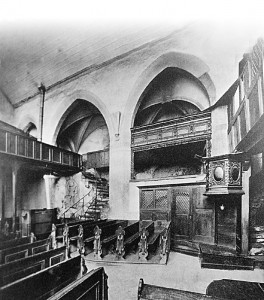Aside from this or other castle chapels, there was a church about _ km outside Oberstein’s gates in an area called “Auf dem Kreuz” (in the vicinity of the former Post Office/Müller drugstore); it is mentioned in documents from 1324, 1329, 1340, and 1382. This house of God was probably dedicated to the Saints Philip and James, Dionysius and Walpurgis. In addition, a chapel in the valley (that is, within the walled settlement) is mentioned for the first and only time in 1430, whose exact location, age, patron, and fate we do not know.

We are relatively well-informed about the construction of today’s Felsenkirche. Since the population of the settlement of (Ober-) Stein at the foot of the castle had steadily increased in the fifteenth century, it was presumably deemed necessary to enlarge the old church in the “Auf dem Kreuz” area or to build a completely new one. If one recalls that the church being used up to that point was not even in Oberstein, and that the old fortification “in the hole” was no longer needed after the construction of two more castles, it made sense to turn the building there into a church, especially since it provided relatively large construction site within the protective city walls.
The pews built in after the rock fall in 1742 with the old ‘sovereign’s seat’, the chapel, the chancel and the ‘apostle pictures’ along the gallery.
On August 23, 1482, Pope Sixtus IV (1471-1484) approved “that the old church outside the small town of Oberstein would be torn down, and a new one built in the settlement by Wirich of Daun, ruler of Falkenstein and of Oberstein…” This man of noble birth was sovereign over the imperial domain of Oberstein; he had become ruler and Count of Falkenstein in the Palatinate a few decades earlier, and he held a number of different offices in the service of other imperial and electoral princes. At the same time, he had the financial resources which were necessary for the extension of the church in Oberstein. On January 18, 1484 (that is, after fewer than 17 months), the new house of God in the rocks was already finished. The unusually short construction period supports the assumption that it was merely a conversion. In order to provide financial security for this measure (“administering the churches in the service of God”), and in agreement with his adult sons and successors, Melchior and Emich, Wirich granted the church a piece of property consisting of eight individual farms in the parish of (Nieder-) Brombach in 1484. The deed of gift reveals that “the old church of Oberstein (had already been) desecrated and the new one in the valley of the lower castle (had been) built and consecrated.”
